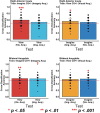Fear in the mind's eye: the neural correlates of differential fear acquisition to imagined conditioned stimuli
- PMID: 36629508
- PMCID: PMC10036874
- DOI: 10.1093/scan/nsac063
Fear in the mind's eye: the neural correlates of differential fear acquisition to imagined conditioned stimuli
Abstract
Mental imagery is involved in both the expression and treatment of fear-related disorders such as anxiety and post-traumatic stress disorder. However, the neural correlates associated with the acquisition and generalization of differential fear conditioning to imagined conditioned stimuli are relatively unknown. In this study, healthy human participants (n = 27) acquired differential fear conditioning to imagined conditioned stimuli paired with a physical unconditioned stimulus (i.e. mild shock), as measured via self-reported fear, the skin conductance response and significant right anterior insula (aIn) activation. Multivoxel pattern analysis cross-classification also demonstrated that the pattern of activity in the right aIn during imagery acquisition was quantifiably similar to the pattern produced by standard visual acquisition. Additionally, mental imagery was associated with significant differential fear generalization. Fear conditioning acquired to imagined stimuli generalized to viewing those same stimuli as measured with self-reported fear and right aIn activity, and likewise fear conditioning to visual stimuli was associated with significant generalized differential self-reported fear and right aIn activity when imagining those stimuli. Together, the study provides a novel understanding of the neural mechanisms associated with the acquisition of differential fear conditioning to imagined stimuli and that of the relationship between imagery and emotion more generally.
Keywords: emotion; fear; fear conditioning; learning; mental imagery.
© The Author(s) 2023. Published by Oxford University Press.
Conflict of interest statement
The authors declared that they had no conflict of interest with respect to their authorship or the publication of this article.
Figures








References
-
- Agren T., Björkstrand J., Fredrikson M. (2017). Disruption of human fear reconsolidation using imaginal and in vivo extinction. Behavioural Brain Research, 319, 9–15. - PubMed
-
- Arntz, A.,, Tiesema, M.,, Kindt, M. (2007). Treatment of PTSD: a comparison of imaginal exposure with and without imagery rescripting. Journal of Behavior Therapy and Experimental Psychiatry, 38(4), 345–70. - PubMed
-
- Beckmann C.F., Jenkinson M., Smith S.M. (2003). General multilevel linear modeling for group analysis in FMRI. NeuroImage, 20, 1052–63. - PubMed
-
- Burleigh L., Jiang X., Greening S.G. (2022). Fear in the theater of the mind: Differential fear conditioning with imagined stimuli. Psychological Science, 33(9), 1423–39. - PubMed

